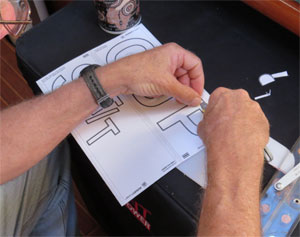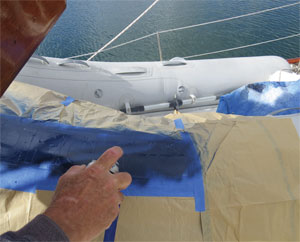We just renewed our boat insurance and one evening, when I had too much time on my hands, I decided to actually read the new policy. I came across a clause that stated that the theft of the dinghy was only covered if the name of the vessel was clearly and permanently marked on it.
There are positives and negatives to putting the vessel name on the dinghy. On the plus side, the dinghy is much more likely to be recovered and returned if the vessel’s name is marked on it — which is, I’m sure, why the insurance company requires it. A thief is less likely to joy ride or try to resell a stolen dinghy that is named. In several places we’ve been, it is required by local regulations to have either the boat’s name or registration number stenciled on the dinghy — usually a visiting boat is given some leeway on local regs, but not always. And finally, a well-marked dinghy is much easier to pick out on a crowded dinghy dock at night amongst a dozen or so very similar looking dinghies.
 |
|
David Lynn cutting out the letter stencils for his dinghy. |
On the negative side, your well-marked dinghy is going to be harder to sell when it’s time to buy a new one. The biggest negative, however, is that when the dinghy is tied up at the dinghy dock, it is a good indication to any would-be thief that the vessel it belongs to is probably unattended at the moment. Using the mother ship’s registration number instead of the name will reduce this possibility, but if the dinghy goes missing, the insurance company may not cover it. And, if someone does find it, matching the registration number on a dinghy to its mother ship is difficult, especially if the vessel is not local.
After evaluating all the pros and cons, we decided in favor of putting our boat name, Nine of Cups, on our inflatable. I’ve put the boat name on several of our previous dinghies as well as numerous life rings, fuel cans and propane tanks, and I find the following method works well for me.
Make the stencil
I start by making the stencil. Using the computer, I experiment with different font types and sizes until I find the right combination. Sometimes this involves printing the boat name in a few different versions on plain paper and temporarily taping them in place to decide which we like best.
Once we are happy with the font, I print the name on my stencil material. While there is commercially available stencil material, it is expensive and not always easily obtainable. I make my own using a combination of letter-sized self-adhesive laminating sheets and letter-sized self-adhesive shipping labels. In my experience, adhesive labels don’t adhere to most surfaces well enough to prevent the paint from bleeding under the stencil. The laminating sheets adhere quite well, but can’t be printed on. I print the lettering on the paper labels, stick these labels to the laminating sheet, and then cut out the letters. Usually, the font size is too large to print the entire boat name on one sheet, but I can usually print each word of the name “Nine of Cups” on one sheet. It’s times like these that I wish we’d chosen a shorter boat name — something like Ta or La would be perfect.
 |
|
Applying the stencils to the inflatable. |
To cut out the letters, I use scissors and a razor. I utilize a straightedge to guide the razor along the straight segments, and either the razor or the scissors to cut the curved segments. Once cut, but before removing the laminating sheet backing, I tape the letters onto the surface to be painted. With each letter lightly held in place with masking tape, it is easy to adjust and move each letter or word until the lettering looks good. Once I am happy with the spacing and positioning of the letters, I tape the letters of each word together if necessary. I put several locating marks on the dinghy surface with a marker, so it will be easy to align the stencil again in the next step.
Securing to the surface
To attach the stencil to the surface, I lift one end of the first word and peel back an inch or so of the laminating sheet backing. I lightly press the laminate against the surface, trying to avoid any wrinkles, bubbles or misalignment. Once the end is lightly stuck in place, I remove the masking tape securing the rest of the word, and begin removing the remaining backing material. As each inch or so of backing is removed, I lightly press the laminate against the surface, using the alignment marks to position each letter. A small positioning mistake can be corrected at this stage by using tweezers or needle-nose pliers to detach and reattach small sections of the stencil. Once the entire word is arranged, I press the stencil firmly in place. The backing material for the center sections of the circular letters — O, P, R, etc. — is next removed and these stencil segments are attached. Once the entire stencil has been applied, I mask around and between each word.
I use ordinary spray paint to paint our dinghy. This has worked well for us and usually outlasts the dinghy — but our inflatable is rarely deflated. If we had a dinghy that was routinely deflated and re-inflated, we might look for a paint that was intended for this purpose.
 |
|
After first thoroughly masking the inflatable to guard against overspray, Lynn applies several light coats of paint. |
Watch out for overspray
It is amazing how much overspray there is on even the calmest day, so I use masking paper to mask a large area around the stencil. If there is any breeze at all, I hold a large piece of cardboard directly downwind of the area I am spraying.
I find that heavier coats of paint are more likely to bleed under the stencil, so I apply several very light coats of paint. I wait 10-15 minutes between coats. Then I wait until it is dry to the touch — one to three hours — and carefully remove the stencil. The laminate material sticks really well, so I sometimes need to use tweezers or needle-nose pliers to peel back a corner of each stencil. The laminate adhesive will often leave a residue, but it best to let the paint cure a day or two before removing it. Alcohol or mineral spirits will remove the residue without damaging the paint after it has fully dried, or the dinghy surface itself.
Once it is all done, I take a few digital pictures. If ever it goes missing, this might be important to prove to the insurance company that we did have the boat name clearly marked on the dinghy.

